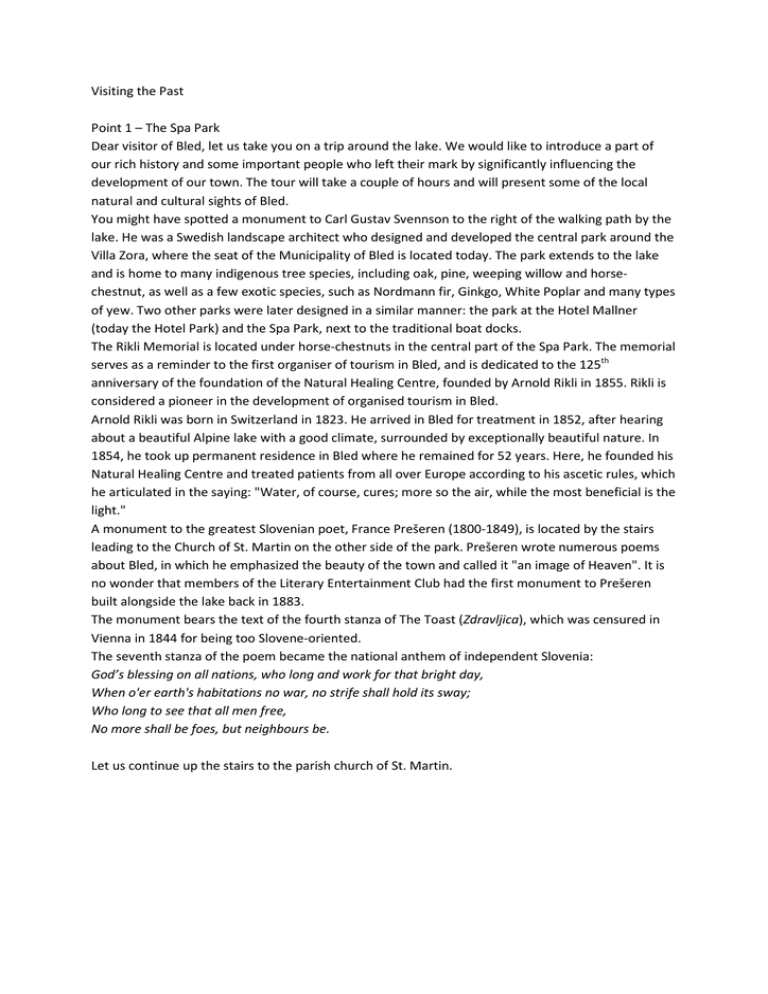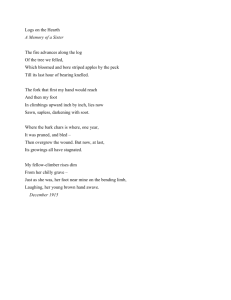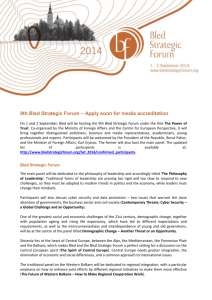Visiting the Past Point 1 – The Spa Park Dear visitor of Bled, let us
advertisement

Visiting the Past Point 1 – The Spa Park Dear visitor of Bled, let us take you on a trip around the lake. We would like to introduce a part of our rich history and some important people who left their mark by significantly influencing the development of our town. The tour will take a couple of hours and will present some of the local natural and cultural sights of Bled. You might have spotted a monument to Carl Gustav Svennson to the right of the walking path by the lake. He was a Swedish landscape architect who designed and developed the central park around the Villa Zora, where the seat of the Municipality of Bled is located today. The park extends to the lake and is home to many indigenous tree species, including oak, pine, weeping willow and horsechestnut, as well as a few exotic species, such as Nordmann fir, Ginkgo, White Poplar and many types of yew. Two other parks were later designed in a similar manner: the park at the Hotel Mallner (today the Hotel Park) and the Spa Park, next to the traditional boat docks. The Rikli Memorial is located under horse-chestnuts in the central part of the Spa Park. The memorial serves as a reminder to the first organiser of tourism in Bled, and is dedicated to the 125th anniversary of the foundation of the Natural Healing Centre, founded by Arnold Rikli in 1855. Rikli is considered a pioneer in the development of organised tourism in Bled. Arnold Rikli was born in Switzerland in 1823. He arrived in Bled for treatment in 1852, after hearing about a beautiful Alpine lake with a good climate, surrounded by exceptionally beautiful nature. In 1854, he took up permanent residence in Bled where he remained for 52 years. Here, he founded his Natural Healing Centre and treated patients from all over Europe according to his ascetic rules, which he articulated in the saying: "Water, of course, cures; more so the air, while the most beneficial is the light." A monument to the greatest Slovenian poet, France Prešeren (1800-1849), is located by the stairs leading to the Church of St. Martin on the other side of the park. Prešeren wrote numerous poems about Bled, in which he emphasized the beauty of the town and called it "an image of Heaven". It is no wonder that members of the Literary Entertainment Club had the first monument to Prešeren built alongside the lake back in 1883. The monument bears the text of the fourth stanza of The Toast (Zdravljica), which was censured in Vienna in 1844 for being too Slovene-oriented. The seventh stanza of the poem became the national anthem of independent Slovenia: God’s blessing on all nations, who long and work for that bright day, When o'er earth's habitations no war, no strife shall hold its sway; Who long to see that all men free, No more shall be foes, but neighbours be. Let us continue up the stairs to the parish church of St. Martin. Point 2 – The Church of St. Martin The present Neo-gothic church dedicated to St. Martin was built in 1905 on the site of a Gothic church from the 15th century. The first chapel occupied the grounds prior to 1000. Plans for the new church were made by Prof. Friedrich von Schmidt, the designer of the Town Hall in Vienna. The architect Josip pl. Vancaš made several alterations to the plans, in particular regarding the interior. The church is decorated by frescos created by the academic painter Slavko Pengov between 1932 an 1937. The new rectory (1871-1872) is located to the right of the church yard, while the old rectory stands opposite (the building dates back to 1460). In front of the church stands a pillar dedicated to the Virgin Mary designed by the greatest Slovenian architect Jože Plečnik before the Second World War. The pillar was carved in Podpeč marble by the sculptor Božo Pengov, while the pedestal is made of the local Straža stone. On the reverse side of the pillar are the Slovenian, Serbian and Croatian coats of arms from the times of the Yugoslavian monarchy. The designer Marko Pogačnik used the Slovenian coat of arms from the pillar as the basic design of the coat of arms of independent Slovenia and included additional Slovenian symbols. A well-maintained path leads from the church to the Bled Castle. The Bled Castle is located on a steep, majestic rock rising 130 metres above the lake and is the oldest castle in Slovenia, first mentioned as castellum Veldes in 1011 as a Royal donation. On 10 April 1004, the German King Henry II donated Bled to Albuin, the Bishop of Brixen. The event took place in the Italian town of Trento. In 1011, Emperor Henry II made another donation to the Bishop of Brixen: the castle upon a rock (castellum Veldes), thus recording its name in a written document for the first time. The Bled Castle was the administrative centre of the Brixen lands in the Gorenjska region. Medieval sources refer to Bled by its German form Veldes. The castle is certainly worth a visit. The view from the castle is astonishing, while you will be charmed by a visit to the castle printing shop, cellars and herbal gallery. After the tour of the castle, we recommend you take a break in the castle restaurant. Lake Bled is of glacier origin and is 14,000 years old. It is 2,100 metres long and 1,400 metres wide, while its greatest depth is 35 metres. Nineteen species of fish live in the lake, in addition to many ducks and swans nesting around it. Above the Castle Lido, one re-joins the walking path that runs for six kilometres around the lake. The Lido attracts many visitors in the summer, as the water warms to 25 degrees C, making Lake Bled the warmest Alpine lake. The route will now take you by the lake to the Slovenian and Bled rowing centre in Mala Zaka. Point 3 – A rowing centre The first rowing infrastructure was built in Velika Zaka back in 1930. In 1954, construction of a rowing centre in Mala Zaka began, with additional works taking place over the course of the next decades. The most recent renovation of the centre took place in 2010 to accommodate the 2011 World Championships. Members of the Bled Rowing Club put Bled on the map prior to the 1950s. Numerous excellent results and the organisational skills of rowing workers has led to FISA’s decision to organise the world rowing championships in Bled four times: in 1966, 1979, 1989 and 2011. The exceptional natural conditions include the Bled rowing course, among the most beautiful and popular rowing sites in the world. Rowers from Bled take pride in their many medals won in rowing championships worldwide. The most cherished are the first Olympic medals won for independent Slovenia. The 1992 Olympic Games in Barcelona saw the Bled rowers win the bronze medal in coxless pair and the bronze medal in coxless four. The first Olympic gold was won in 2000 in Sydney in double pairs, followed by the silver medal in the same discipline during the 2004 Olympics in Athens. A bust of Boris Kocijančič is located next to the boat house in Mala Zaka, commissioned by Slovenian and Bled rowers in 1969 in memory of this long-standing presidency of the Rowing Federation of Slovenia. He also organized the European and World Championships of 1956 and 1966 in Bled. The bust was made by the academic sculptor Stojan Batič. Slightly further away, on a lawn by the lake, stands an imposing statue of a rafter. It was made by the sculptor Boris Kalin before the Second World War and is considered one of his most beautiful works. A memorial plaque to Thomas Keller, a long-standing president of the International Rowing Federation (FISA), can be seen on the rowing dock. The names of Olympic sites where rowers from Bled have competed and won medals are carved in the floor in front of the dock. Above the rowing centre one can see Hotel Triglav, which is more than 100 years old. Opposite the hotel is the Bled railway station, occupying the most beautiful location on the Bohinj railway. The railway was opened on 19 July 1906 in a grand celebration witnessed by the heir presumptive, the Archduke Franz Ferdinand himself. The Bohinj railway was a great achievement of the project managers and builders of the monarchy. It had a significant impact on the development of tourism in Bled. The station’s memorial room is an interesting monument to those days. The lake route will now lead you to Velika Zaka, the site of the finish lines of rowing regattas, as well as a paradise for camping aficionados, as the location of one of the loveliest camps. Point 4 – The Villa Bled As early as the Austro-Hungarian Empire, a mighty park growing around the Villa Bled provided shelter to the mansion of Ernest, Prince of Windischgrätz. From 1920, the mansion served as a summer residence of the Yugoslav royal family of Karađorđević. Suvobor was torn down between 1937 and 1938 and a mansion began taking shape instead. However, the works were halted due to the Second World War. After the war, the villa served as a presidential residence of Yugoslav leader Josip Broz Tito who invited many important statesmen and stateswomen including Haile Selasie, Khrushchev, King Hussein, Indira Ghandi and Nasser. Around 120 fascinating tree species are planted in the park. Needless to say, the eye strays to the lake where the only Slovenian island is located. Ninety-nine stairs lead to the top of the island, with the slope of the Karavanke in the background, its highest peak Stol reaching to a height of 2,236 metres. The Bled Island belongs to the oldest pilgrim routes in the Gorenjska region and is the site of rich history. We may presume that pilgrims were the first tourists on the island. Nevertheless, a wish to visit Bled, as well as a climb to the castle and a boat trip to the island, is shared by all tourists in the region. The first stone church on the island stood there in the form of a Romanic basilica with three naves between 1124 and 1245. A sacral structure on the island was first mentioned in a document from 1185, when Bishop Henry confirmed the donations of Bishop Hartmann to the church on the island. In 1465, the church was redesigned in the Gothic style. In 1523, it was rebuilt after an earthquake, which occurred in 1511 and demolished the nave and the bell tower. By the early 15th century, the church was already a well-known destination of pilgrims. In 1622, another earthquake caused damage that was repaired in 1680. The church got its present form between 1679 and 1691. In 1655, a stairway from the shore to the top was added. The surrounding buildings and a side chapel were built in the 17th century. The poet France Prešeren placed the Bled Island in the centre of Slovenian mythology with his poem Baptism at the Savica. The poem depicts an idyllic image of Bled and the island, as well as the temple of the Goddess Živa. The route takes you past Mlino, a village where pletnas, traditional hand-crafted boats that take tourists to the island, were "invented". Point 5 – The Grand Hotel Toplice To the right of the hotel rises Straža (646 metres), a hill that served for tourist purposes back in the times of Arnold Rikli. Numerous paths and ways lead across the hill slopes, where people enjoy recreation, as well as fitness exercises and health preservation or rehabilitation treatments. A monument to Arnold Rikli stands on the hill, built by his sons in the memory of the first organiser of tourism in Bled. Today, Straža offers a renovated fitness track and many attractive activities for all ages, ranging from an adventure park to a summer sledding run. Five exquisite vantage points, offering breathtaking views, are also worth mentioning. We are now standing next to the oldest and most renowned hotel by the lake. In 1818, a thermal spring was constructed, and covered in 1822. The water was later channelled into pools that were named the Prešeren Lido (baths). In 1850, the postmaster Hoffmann built a hotel that was named Luisenbad by his successor Luckmann. In 1853, the Prešeren Lido was renovated and Badehaus, a public bath, added. Badehaus was enlarged in 1875 by the owner of Luisenbad, Count Camillo Aichelburg. Jula Vovk Molnar, a local, bought Luisenbad in 1919 and renamed it Grand Hotel Toplice. She had a new bath constructed, as well as Belvedere, a hotel annex, and the present Hotel Jadran. She also had the Villa Adria (now Korotan) renovated. She increased the hotel capacity to 205 beds. The majority of the works took place between 1930 and 1931. From that time until the present day, the hotel was renovated on several occasions in order to remain the best of the best. The hotel is still visited by most the well-renowned guests from all over the world. King Alexander Karađorđević decided to move his summer residence to Bled, which resulted in many important guests and diplomats staying at the Grand Hotel Toplice. Numerous meetings and conferences took place at the hotel. The leadership of the Little Entente, an alliance between the Kingdom of Yugoslavia, Czechoslovakia and Romania, met here three times, in 1926, 1935 and 1938. Not only politicians and diplomats stayed at the hotel. The guest book reveals the names of other celebrities, including Ivan Meštrović, a world-renowned sculptor, opera bass singer Fyodor Shalyapin and film actress Ita Rina. Immediately after the renovation in 1931, an international chess tournament took place at the Grand Hotel Toplice, with the world champion Dr Alexander Alekhin winning first place. In 1965, the Slovenian PEN Club organised a world congress of writers in the Festival Hall in Bled. Numerous writers stayed at the Grand Hotel Toplice, including Arthur Miller, the President of the International PEN Club, and two Nobel Prize winners: Ignazio Silone and Pablo Neruda. We suggest that you conclude the Visiting the Past tour around Lake Bled by tasting the renowned kremna rezina (vanilla and custard cream cake), while enjoying your own personal view of the "image of Heaven".


